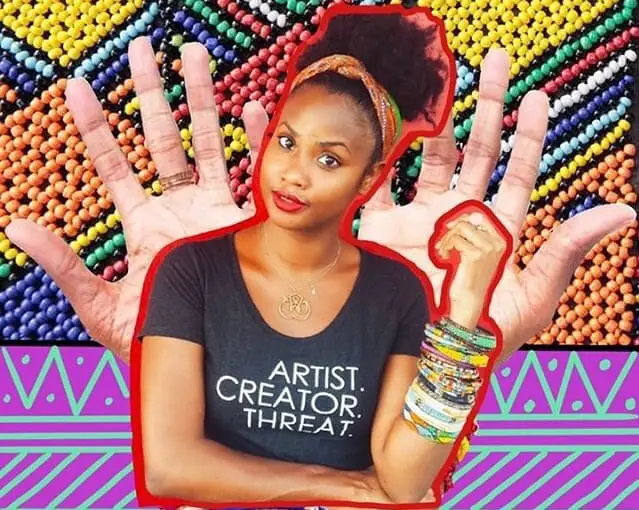Brianna McCarthy considers herself a communicator instead of an artist, and her drawings, paintings and fabric collages speak to the complexities of identity and what constitutes beauty — especially black identity and beauty — in the wake of the African diaspora. Her range of emotional expression and personal awakenings are buried in the layers of patterns and colors that compose her portraits.
McCarthy was born and raised in Trinidad and Tobago, a dual-island Caribbean country near Venezuela. She identifies as a black, West-Indian female, and her background has a heavy influence on her work, embodying the life and beauty she tries to encapsulate. Beauty is a fickle and dichotomized concept, but one McCarthy explores nonetheless.
After seeing the work of Romain de Tirtoff (better known as Erté), the Russian-French artist who helped create the art deco period and whose artwork included drawings and sculptures of black women, McCarthy realized for the first time that there was hardly any representation of black women in art. The next problem was that there wasn’t anything that represented her. “I thought, ‘This is fantastic!’” she told Summer Edward. “‘But where can I find some where the women look like me?’”
Unlike Erté’s drawing of a faceless brown woman in a ruffled, gray-gradient gown, the focal point of McCarthy’s work is the human face. McCarthy’s aim is to examine “issues of beauty, stereotypes, [and] representation,” a feat she tackles in various collections, including “Anima/us Botanica” and “Goldings.”
In mostly black and white, “Anima” — the feminine component of a man’s personality — dissects female beauty. McCarthy turns an Afro woman’s face into a sectioned, geometric plate. The black undertones are broken by fine, white lines that mimic muscle fibers, as if McCarthy is going beneath the skin, evoking the century-old “beauty is only skin deep.”
McCarthy literally goes beneath the surface we judge to reveal the bare basics and manages to still capture the outer and inner beauty. The woman’s long, slender neck is adorned in colorful leaves, and in another it grows from her hair, as if in homage to the beauty and vibrancy of her culture.
https://www.instagram.com/p/BBGezkbFhhd/
Studies show that people automatically factor in symmetry and familiarity when determining whether or not someone is attractive, and either intentionally or inadvertently, McCarthy highlights the symmetry and angles of the human face. Familiar symmetry considers how our faces are slightly asymmetrical but in different ways, and the average face — with similar symmetrical features — is usually what most people are attracted to within a society.
Anthony Little, a psychologist at the University of Stirling in Scotland, said, “Averageness includes all kinds of factors, such as the size of the features of your face and their arrangement.” It’s a major factor that even extends to other animals, such as swordtail fish and peacocks.
McCarthy’s “Goldings” is similar, but only colored-blocks divide the women’s faces, many adorned in golden jewelry and their hair speckled in gems that mirror the stars. The leaves now lie in the background. Again, McCarthy twists and challenges identity and beauty, particularly “shadism.” With women of various colors, from brown to black and white to tan, there arises an issue of inadequate representation of women in the media, and the media is a major player in establishing beauty standards despite biological factors.
https://www.instagram.com/p/ll6Bdjlhpg/
Asia Leeds, a Spelman College professor, said she observed women in Senegal and Zimbabwe bleaching their skin to increase their chances of finding a husband. African-American beauty had only been represented by figures like Beyoncé and Rihanna at the time, but highlights the dangers of promoting an idealized concept of beauty.
“The preference for averageness itself is biologically based,” psychologist Coren Apicella said, but in order for people to learn what the average face looks like, they have to see other faces, and a study by Kaitlin Ryan and Isabel Gauthier at the Vanderbilt University in Nashville discovered that exposure to more faces is crucial, including non-human faces.
McCarthy’s “Vetiver Night Women” is an elevation of African beauty that actually seems to echo Erté’s “D” from the Alphabet series. Both depict women with star-studded skin that captures their mystical power. Erté mimics the miniature deities of Persia, while McCarthy mirrors the saints of the Christendom. The women’s skin in McCarthy’s pieces are as black as the night sky they emanate from, and many have golden disks surrounding their heads. Even in these paintings, their cheekbones and brow ridges are outlined in white.
https://www.instagram.com/p/BSTyrmohv10/
The natural and geometric patterns McCarthy paints, infused with variegated colors or markings, are pieced together to create a unified self or a beautiful, wholly human self, yet are still distinct. “I made these masks, new faces for my-self, embodiments of my otherness and sameness,” she wrote of her “SelfPortraits as Maker+Mender.”
In two photographs, she explores the dual identity people of mixed-backgrounds attempt to balance in a world where assimilation is crucial for survival. Again, she uses colors and patterns cut from fabric in precise shapes to highlight facial features, speaking to the complex forms of both beauty and identity.
















